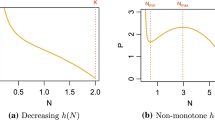Abstract
The supplantation of one of two closely similar competing species by the other (Volterra-Lotka principle) is studied as an example, according to Volterra's general theory of population dynamics, of the decay of a biological association of an odd number 2n+1 of species into one with an even number 2n. The three-species association (n=1) is worked out in detail, with a demonstration of how a Volterra predator-prey cycle gets gradually deformed—when a slightly superior predator is introduced—into another new-predator-prey cycle, spelling a steady eclipse of the original predator. Whenn is made large, the close competitors being embedded in an association of many other species, a statistical treatment of the supplantation process can be given through the author's statistical-mechanical theory of Volterra's dynamics. The result is a probability law, changing systematically as time goes on, for the chance that the successful competitor's population has any given amplitude; explicitly time-dependent measures of mean amplitude and mean frequency of oscillation of all populations can then be worked out. Throughout, the simplifying assumption is made that the competitors differ only as regards intrinsic rate of self-growth. Two things are accomplished by viewing the competition as a decay of 2n+1 into 2n: the competitors are not abstracted from the rest of the biological world, and their population variations are always oscillatory (with long-term rises and falls of amplitude); this is in contrast to the original Volterra-Lotka analysis in which purely static, and therefore ecologically unrealistic, population levels of but two species eventuate.
Similar content being viewed by others
Literature
Cole, L. C. 1960. “Competitive Exclusion.”Science,132, 348–349.
D'Ancona, U. 1954.The Struggle for Existence. Leiden: E. J. Brill.
Haldane, J. B. S. 1924. “A Mathematical Theory of Natural and Artificial Selection.”Proc. Camb. Phil. Soc.,23, 19–41.
Hardin, G. 1960. “The Competitive Exclusion Principle.”Science,131, 1292–1297.
Lotka, A. J. 1932. “The Growth of Mixed Populations.”Jour. Wash. Acad. Sci.,22, 461–469.
Kerner, E. H. 1957. “A Statistical Mechanics of Interacting Biological Species.”Bull. Math. Biophysics,19, 121–146.
— 1959. “Further Considerations on the Statistical Mechanics of Biological Associations.” —Ibid.,21, 217–255.
Volterra, V. 1926. “Variazioni e fluttuazzione del numero d'individui in specie animali conviventi.”Mem. Accad. Lincei.,II, ser. 6, 31–112.
— 1932.Leçons sur la theorie mathématique de la lutte pour la vie. Paris: Gauthier-Villars.
Author information
Authors and Affiliations
Rights and permissions
About this article
Cite this article
Kerner, E.H. On the Volterra-Lotka principle. Bulletin of Mathematical Biophysics 23, 141–157 (1961). https://doi.org/10.1007/BF02477468
Received:
Issue Date:
DOI: https://doi.org/10.1007/BF02477468




